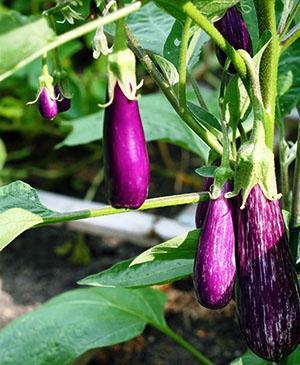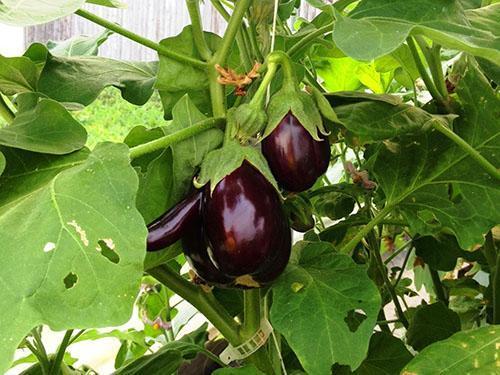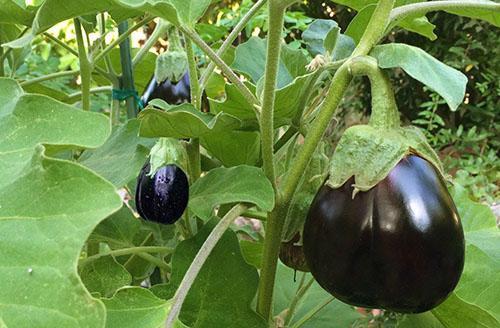Possible mistakes when growing eggplant
 Eggplants enjoy increased attention of gardeners, but until recently, not everyone managed to grow tasty healthy vegetables on their site. Not only are eggplants from the entire family of nightshades considered the most thermophilic, their cultivation has some subtleties.
Eggplants enjoy increased attention of gardeners, but until recently, not everyone managed to grow tasty healthy vegetables on their site. Not only are eggplants from the entire family of nightshades considered the most thermophilic, their cultivation has some subtleties.
However, even after experiencing the bitterness of failure, you should not despair. Thanks to the emergence of early unpretentious varieties and knowledge of the characteristics and preferences of the culture, growing eggplants will not be difficult even in regions where gardeners previously could not think of such a plant in the garden.
What is the key to success in growing eggplant?

- If the plant is experiencing a lack of lighting, this necessarily affects not only the yield, but also the health and growth rate of bushes and fruits.
- A similar result should be expected with a lack of moisture.
- When the temperature drops, many varieties refuse to form an ovary at all and even shed existing fruits and buds.
For comfortable fruiting eggplant a temperature of about 25-28 ° C is needed, while in hotter weather with sufficient moisture, this culture feels better than related species.
Asking the question why do eggplants turn yellow, gardeners should pay attention to the quality and fertility of the soil, the culture is especially sensitive to the production of potassium and phosphorus.
 When growing eggplant, it is extremely important to remember the rules of crop rotation and not to plant this crop after potatoes, tomatoes or peppers. In order to avoid the development of eggplant diseases caused by common pathogens and pests, you should not arrange eggplant beds next to plantings of related crops.
When growing eggplant, it is extremely important to remember the rules of crop rotation and not to plant this crop after potatoes, tomatoes or peppers. In order to avoid the development of eggplant diseases caused by common pathogens and pests, you should not arrange eggplant beds next to plantings of related crops.
Preparation for sowing
 Since the growing season for eggplants is from 85 to 140 days, and climatic conditions in most regions cannot please gardeners with such a long and warm summer, it is advisable to grow this type of nightshade through seedlings.
Since the growing season for eggplants is from 85 to 140 days, and climatic conditions in most regions cannot please gardeners with such a long and warm summer, it is advisable to grow this type of nightshade through seedlings.
For sowing, a loose soil that retains moisture well is prepared from:
- 2 parts of humus;
- 1 part lowland peat;
- 1/2 part aged sawdust or sand.
It is from this stage that the prevention of eggplant diseases begins, and the foundations of the harvest are laid.
It is categorically impossible to use the seedlings of this culture:
- fresh organic matter that can damage the young root system;
- fresh sawdust that increases the acidity level and introduces resinous substances into the soil, they must be kept after darkening or spilled several times with boiling water;
- garden soil and humus untreated with potassium permanganate, in which pathogens and pest larvae can persist.
To enrich the soil for growing eggplants with nutrients, 100–150 grams of wood ash, dolomite flour, normalizing acidity, and complex mineral fertilizers are added to 10 kg of prepared soil mixture or ready-made soil for nightshade crops.
The most direct influence on the future harvest is the choice of seed.
 Therefore, the sorted seeds are disinfected for 30 minutes in a 1% solution of potassium permanganate, which allows future plants to be rid of diseases, infections and insects that affect eggplant.
Therefore, the sorted seeds are disinfected for 30 minutes in a 1% solution of potassium permanganate, which allows future plants to be rid of diseases, infections and insects that affect eggplant.
Then the seeds are soaked for 4-5 hours using a solution of boric acid, ready-made growth regulators, infusion of manure or wood ash. This technique will speed up germination and give the sprouts extra strength.
Sowing eggplants and growing seedlings
 If dry seeds, sown to a depth of 1.5–2 cm, emerge only through 8–10 nets, then the pre-soaked seed hatches already in 4–5 days. This result can be obtained by placing the seeds in a humid environment at a temperature of 25 ° C for 4–5 days. Sowing is carried out in moist soil, and then the future seedlings, until the first eggplant sprouts appear, should remain under the film at a temperature of 20-25 ° C.
If dry seeds, sown to a depth of 1.5–2 cm, emerge only through 8–10 nets, then the pre-soaked seed hatches already in 4–5 days. This result can be obtained by placing the seeds in a humid environment at a temperature of 25 ° C for 4–5 days. Sowing is carried out in moist soil, and then the future seedlings, until the first eggplant sprouts appear, should remain under the film at a temperature of 20-25 ° C.
In order for the seedlings to activate the growth of the root system, the next 5-6 days eggplant cultivation is carried out in the cool. The optimum temperature in this case is 18 ° C.
With a temperature background below 13 ° C, eggplants turn yellow, wither, and the risk of developing a black leg increases. Drafts create the same effect.
For seedlings that form in a rather dark season, it is necessary to equip a backlight that provides a daylight hours lasting 12-14 hours. This will accelerate the growth of the seedlings, prevent them from stretching and lay the foundation for an early onset of flowering. When real leaves appear on the plants, it's time to pick them. Eggplants must be passed over with an earthen clod in order to preserve the rather tender root system of the sprouts.
For the first time, the seedlings are watered a couple of days after sowing, using settled water heated to 25–30 ° C. In the future, the plants also require comfortable warm water, which the sprouts receive every 2-3 days, and then, as they grow, after five days.
For both seedlings and adult eggplant plants, it is important that the leaves do not get wet when watering. Excessively moist soil threatens the occurrence of eggplant diseases and even the death of plantings.
 In addition to moisture and light, seedlings should receive regular feeding. First, using mineral fertilizers, carried out after 8-15 days, depending on the state of the plants. In the future, eggplants can be fertilized with regularity for two weeks, supporting the seedlings with potash and phosphorus mixtures.
In addition to moisture and light, seedlings should receive regular feeding. First, using mineral fertilizers, carried out after 8-15 days, depending on the state of the plants. In the future, eggplants can be fertilized with regularity for two weeks, supporting the seedlings with potash and phosphorus mixtures.
7-10 days before transplanting eggplants to a permanent place in a greenhouse or in the open field, the seedlings are hardened in order to accustom the plants to temperature fluctuations, natural light and air movement.
Features of agricultural technology when growing eggplant
 Subject to the rules of cultivation, before planting in the ground, eggplants have a height of about 20 cm and have a powerful root system, a strong stem and up to 8 true leaves.
Subject to the rules of cultivation, before planting in the ground, eggplants have a height of about 20 cm and have a powerful root system, a strong stem and up to 8 true leaves.
So that the plants do not experience serious discomfort after transplantation, loose nutrient soil is prepared for them in the fall, which is useful to disinfect after previous crops.
For disinfection use 1-2 tablespoons of copper sulfate in a bucket of water. Next, the soil is dug up.
- In the spring, heavy soils are once again subjected to digging and along the way they bring in sand or sawdust, and light sandy loam soils only loosen.
- Up to 0.75 buckets of high-quality rotted organic matter, dolomite flour, up to 5 kg of low-lying peat are introduced per meter of the area of the garden. The amount of additives may vary depending on the type of soil on the site. If necessary, you can use complex ready-made fertilizer mixtures.
The eggplants are planted in holes 10–15 cm deep when the soil warms up to 15 ° C. Since adult plants are quite voluminous, it is better to leave an interval of up to 60 cm between the holes.And so that the soil does not lose moisture, after planting the seedlings, the soil is mulched, and the plants are covered with non-woven material that will protect the sprouts from temperature fluctuations and the scorching rays of the sun.If this is not done, eggplants turn yellow, acclimatize poorly and for a long time, becoming a target for pests and pathogens.
 Eggplants love moist soil up to 20 cm deep, but they have a negative attitude to watering with cold water, therefore, both seedlings and adult fruiting bushes need moisture with a temperature of at least 20 ° C. Shallow, gentle loosening after watering will help to save moisture.
Eggplants love moist soil up to 20 cm deep, but they have a negative attitude to watering with cold water, therefore, both seedlings and adult fruiting bushes need moisture with a temperature of at least 20 ° C. Shallow, gentle loosening after watering will help to save moisture.
If eggplant cultivation is carried out in a greenhouse or greenhouse, excessive humidity should not be allowed, leading to the development of rot, other eggplant diseases and the appearance of aphids. In addition, in such conditions, pollen loses its properties, and you should not expect a good harvest. Good ventilation will help correct the situation. It will also save when the temperature rises above 35–45 ° C, when the yellowing of the eggplants, the fall of flowers and the formed ovary are noted.
During the growing season, eggplants are fed 3 to 5 times, focusing on the needs and condition of the plants.
If, before the beginning of fruiting, it is worth paying more attention to complex mineral fertilizers and replenishment of microelements, then with the onset of eggplant formation, priority is given to phosphorus and nitrogen mixtures. Moreover, organic matter in excessive quantities can adversely affect the harvest, since the plant grows, but the flowering activity decreases. In this case, the introduction of potash fertilizers, provoking eggplants to form buds and ovaries.
 During long, wet, cool periods, foliar feeding is useful, supporting the eggplant with trace elements.
During long, wet, cool periods, foliar feeding is useful, supporting the eggplant with trace elements.
The success of eggplant growing depends not only on watering and fertilizing, but also on the competent formation of the bushes. Sometimes, excessive plant density is more harmful to the crop than a lack of moisture.
Removing excess foliage and shoots without an ovary allows:
- direct nutrition to the fruit;
- increase the lighting of the inside of the bush;
- avoid the development of eggplant diseases and the settlement of pest colonies on plants.
Diseases of eggplant
 Observing the rules for growing eggplants, you can significantly reduce the risks of diseases dangerous to the culture. And yet, even with proper watering, fertilization, planting plants, it is not possible to achieve the proper yield.
Observing the rules for growing eggplants, you can significantly reduce the risks of diseases dangerous to the culture. And yet, even with proper watering, fertilization, planting plants, it is not possible to achieve the proper yield.
Serious damage to eggplants is caused by diseases of a viral, fungal and infectious nature, the peak of which occurs during rainy, cool periods.
 Black spot is bacterial in nature and begins to infect plants with high humidity and high daytime temperatures. The disease manifests itself in the form of dark spots located along the veins of the leaves, along their edges, on the stalks and cuttings. As the eggplant disease progresses, fruits are affected and become covered with overgrowing dark glossy spots.
Black spot is bacterial in nature and begins to infect plants with high humidity and high daytime temperatures. The disease manifests itself in the form of dark spots located along the veins of the leaves, along their edges, on the stalks and cuttings. As the eggplant disease progresses, fruits are affected and become covered with overgrowing dark glossy spots.
In the southern regions of the country, gardeners may encounter a viral mosaic, manifested in a change in the color and shape of foliage. As the disease progresses, alternating dark and light green areas appear on the leaf plates, more noticeable on the tip of the shoots. As a result, the eggplant plants turn yellow, the leaves are noticeably deformed, the flowering and the amount of ovary decrease.
 With viral internal necrosis, which also develops at high humidity, areas of dead brown tissue appear on the fruits of eggplants, which sharply reduces the yield. As preventive measures and to exclude the development of eggplant diseases, the following techniques are used:
With viral internal necrosis, which also develops at high humidity, areas of dead brown tissue appear on the fruits of eggplants, which sharply reduces the yield. As preventive measures and to exclude the development of eggplant diseases, the following techniques are used:
- collecting seeds only from healthy ripe fruits;
- disinfection and selection of inoculum;
- disinfection of soil at the site of planting and soil in sowing containers;
- compliance with crop rotation;
- selection of healthy seedlings;
- destruction of plant residues in the beds;
- compliance with agricultural standards.
For the treatment of affected plants, observing precautions, they use drugs of chemical and biological control, carry out foliar dressings that increase the resistance of eggplants, and also necessarily disinfect the used equipment.
Diseases of eggplant with malnutrition
 Why do eggplants turn yellow, refuse to bear fruit, and seemingly die for no apparent reason? Sometimes plants suffer from an imbalance in the mineral composition of the soil, an overabundance or lack of basic nutrients.
Why do eggplants turn yellow, refuse to bear fruit, and seemingly die for no apparent reason? Sometimes plants suffer from an imbalance in the mineral composition of the soil, an overabundance or lack of basic nutrients.
Nitrogen has a direct effect on the growth of the bush, and the lack of this element negatively affects the size and appearance of leaves and shoots. They become small and pale. The fruits are deformed, do not develop properly and fall off. An excess amount of nitrogen provokes the active growth of green mass and inhibition of the formation of fruits, moreover, the element can accumulate in the form of nitrates dangerous to humans.
 Falling foliage and its acquisition of a purple hue is possible with a lack of phosphorus in the soil, one of the three main nutrients. But eggplants react especially sharply to a lack of potassium during the period of active fruiting. This is expressed in the fact that the eggplants turn yellow, the edges of the leaves dry out, and the fruits become stained. Plants grown on acidic soils after liming, as well as during dry periods, have a special need for the element.
Falling foliage and its acquisition of a purple hue is possible with a lack of phosphorus in the soil, one of the three main nutrients. But eggplants react especially sharply to a lack of potassium during the period of active fruiting. This is expressed in the fact that the eggplants turn yellow, the edges of the leaves dry out, and the fruits become stained. Plants grown on acidic soils after liming, as well as during dry periods, have a special need for the element.
A noticeable yellowing of the leaves and their dropping can be seen with a lack of magnesium and manganese in the soil, and in the latter case, the picture resembles a mosaic of leaves, but the eggplant quickly restores its healthy form after the introduction of trace elements.
The lack of calcium and boron in the soil negatively affects the development of plants. And in such cases, eggplants look depressing and require urgent measures in the form of soil or foliar dressing.
Thanks for the extensive and very helpful material on growing eggplant. I myself am Siberian and I don't find a special taste in eggplants. But the neighbor is Ukrainian. She has been trying to grow eggplants in a greenhouse for many years, but she does not get more than one fruit from the bush. Usually, in July, her plants are all in white flour, and then they remain completely without leaves. I read it and understood that it was necessary for my neighbor to copy this entire material.
She brings good seedlings, but then plants them on a hot manure heap, but it turns out that they don't like fresh eggplants. And as I watch, the place does not change, but they need to be relocated. Yes, and placed in the same greenhouse with cucumbers, not tomatoes. There is not enough ventilation, the humidity is high. I understood. It remains only for the neighbor to understand her mistakes.